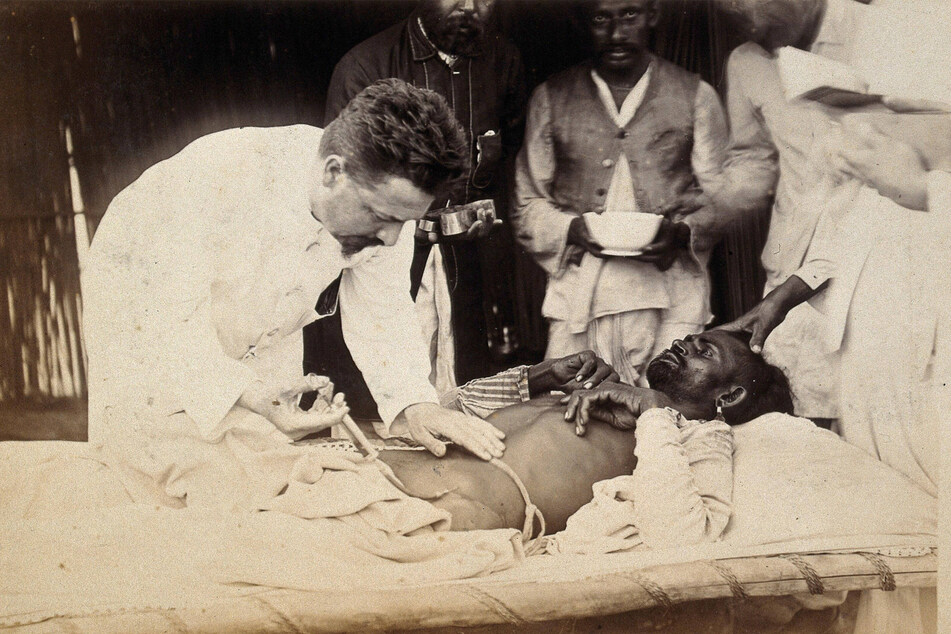The bubonic plague still exists in America
After years of a pandemic and the looming climate change crisis on our doorstep, fears that the bubonic plague will return with the melting ice don't seem so absurd. Once you start digging, you'll quickly realize that it's still out there, in nature, biding its time.

This article was originally going to be about something very different and very specific - the risk that climate change-induced glacier (and icecap) melts could unleash all manner of pestilence - but a short amount of research revealed something far more frightening.
One of the biggest fears of climate change is the thawing of land that has been left frozen in time for hundreds, thousands if not millions of years. Known as permafrost, this frozen matter is more than just ice - it's soil, bacteria, fossils.
The fear at hand is two-fold: 1) That the melting permafrost will continue to release huge amounts of stored CO2, further exacerbating climate change and creating a feedback loop (the soil melts, releases carbon dioxide, which then worsens global warming and causes more melting to occur), and 2) The very real fear that some of these bacteria will be deadly.
It was while researching this topic that something quite bizarre turned up: An NBC News report published in August 2020 headlined "California confirmed first case of plague in 5 years: What to know".
The article was careful not to stoke too much fear (at the time, America was about six months deep into the Covid-19 pandemic and still reeling from the death of George Floyd, who had died less than 3 months prior), and even quoted experts in an attempt to reassure the public. Still, though, bubonic plague in 2020?
Over the hundred-or-so years between 1900 and 2012, the CDC reported that there had been 1,006 "confirmed or probable" cases of bubonic plague in the United States. Even scarier, the World Health Organization receives 1,000–2,000 reports of suspected plague worldwide every single year.
This isn't reported on much, though, is it? So, why are people scared that the ice caps melting will release the plague if it's already here? To answer that question, we first need establish what the bubonic plague or "Black Death" actually is.

So, what actually is bubonic plague?
The bubonic plague is a disease believed to spread through the bacteria Yersinia Pestis (though the origin of certain historic "plagues" are the cause of heated debate among historians and epidemiologists). It causes swollen and painful buboes (lymph nodes) as well as fevers, headaches, and other symptoms.
In the fourteenth century, Yersinia Pestis was believed to have caused the "Black Death," a wave of disease and pestilence that spread across the world. It is believed that this pandemic killed at least one-third of Europe's population at the time, the equivalent of more than 25 million people.
The scale of destruction induced upon humanity has scarred history forever, with the plague of 1348 an iconic symbol in art and global culture, particularly in Europe. It has appeared time and time and again throughout history, killing millions upon millions of people.
Spread originally through flea bites, the modern plague takes on three distinct forms, each progressively worse than the other:
Bubonic plague: The most simple and common form of the plague, bubonic plague, took its name from the "Buboes" that would form on the lymph nodes of its victim. During the 1340-50s plague, only 18% of victims survived.
Pneumonic plague: Potentially one of the most dangerous forms of the plague, the pneumatic form attacked the lungs and was almost certain to kill you. Those world-famous hazmat suits with the beaked mask were developed as a result of the pneumonic variant. It is considered the most dangerous because it can be spread from human to human via particles breathed into the air.
Septicemic plague: This final phase of the plague attacked a person's circulatory system. Blood clots would form right across the body, producing rashes as well as red and black blotches on the victim's skin. It was not uncommon that the infected person would die within 24 hours of the first symptoms showing.
Plague has been a fact of life across the history of humanity and is often credited as a potential catalyst for yet-unexplained historical events. With this in mind, why aren't people panicking over the "plague in the USA"?
What's the difference between modern day bubonic plague and the Black Death?

So far, everything has been remarkably frightening, and for good reason. Major economic changes came to Europe in the years that followed the 1348 plague because, with almost half the population gone, there was a demand for work but a very limited supply of employees. Such was the scale of carnage, anyone shocked by this article's headline has very good reason to be.
Luckily, after doing a little more digging, it seems that we don't need to worry too much about the bubonic plague that still exists in places like America and central Africa.
As previously stated, the bubonic plague was thought to be caused by a bacteria called Yersinia pestis, which is usually found in small rodents and spread through fleas. With this in mind, the first thing to note is that animals like rats are far fewer in the modern day than they were when the black plague was at its height in the 14th century.
The World Health Organization shares that modern variations of the bubonic plague have a case-fatality ratio of 30 to 60 percent when left untreated. If the pneumonic form of the plague is left untreated, though, that fatality rate reaches nearly 100 percent even today.
When it comes to pneumonic plague, this is a fatality rate that remains relatively unchanged, but the bubonic form's fatality rate is significantly lowered. This is already a big difference and a symptom of the fact that modern-day Yersinia pestis is likely a variant of the original plague bacteria and not the same thing.
The other difference is quite obvious: Quality and availability of proper medical treatment. Antibiotics are an effective treatment against modern plague bacteria, meaning that these fatality rates are significantly lower in people who have access to such drugs.
The current version of Yersinia pestis is less lethal than it was in the 1300s, and we have far better treatments available. On top of that, healthcare systems around the world are far better at dealing effectively with outbreaks than they were even one hundred years ago.
Will the Black Death return?
So, should we be scared? Well, no. There are only three countries where plague is classified by the WHO as "endemic:" the Democratic Republic of the Congo, Madagascar, and Peru. Indeed, bubonic plague has been completely wiped out in many areas of the world, such as Oceania and most of Europe.
Yes, Yersinia pestis exists in the US, but it poses little-to-no threat to the country. With the disease being so unbelievably rare, a relatively robust healthcare system, and readily-available antibiotics, it is unlikely to ever return as a deadly global pandemic. At least in its current form.
So why are people worried about the ice caps and glaciers melting?
With vast frozen expanses of the world defrosting, a lot of long-frozen bacteria is likely to be released. Older and more lethal variants of Yersinia pestis are very likely to be among these bacteria. It's simply unknown whether modern-day antibiotics would be of help against such a calamity.
Whether this does pose a real and worrisome threat to humanity, though, is perhaps a question best directed at epidemiologists or, indeed, a future article.
Cover photo: Collage: IMAGO/Shotshop/Hohlfeld




